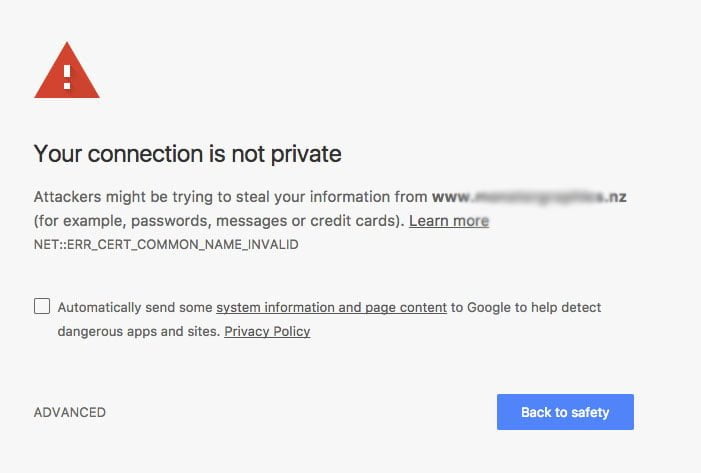In this blog post we are not going to look at your website, but instead at the first step to reach your website: the URL and how to get it up to 2017’s security standards.
From October 2017 on, Google’s Chrome browser will take the next step in their long-term plan to make the internet a safer place and get every website to use a secure protocol called https. If this last bit sounded like a foreign language to you, don’t worry – read on, we’ll get into the what’s and how’s.
The URL puzzle pieces
URL is short for: Universal Resource Locator. Any website’s URL can be divided into several pieces, just like a puzzle. These puzzle pieces serve all different purposes. Today we are going to take a closer look at the first piece, which I’m sure you have all noticed, but not given much attention – just as long as it works right?
Let’s use Monster Graphics URL as example: https://www.monstergraphics.nz
- https://
- www (which stands for world wide web)
- monstergraphics.nz (is the chosen domain name, in 90% of the cases, the company name)
“https”, “www” and “monstergraphics.nz” are the three puzzle pieces of this, actually any website’s URL. Let’s take a closer look at the first part, the “https://”. At Monster Graphics, we have only recently changed our URL from http://www.monstergraphics.nz to https://www.monstergraphics.nz . A possibly undetected tiny yet important difference we undertook by adding the “s” to the http bit. It simply stands for secure. Still confused? Don’t worry keep reading we’ll decipher further.
What is http and https
Until now, most websites use an http protocol which stands for “Hyper Text Transfer Protocol”. The tiny yet important difference between http and https consists in the “s” which stands for secure and makes your connection more secure than before by encrypting all data sent between browser and website. The sole difference between “http” and “https” is an extra layer of security.
https vs http
Websites using a simple http protocol sent your data as plain text between the server and your computer. This makes your data, like your e-mail address or text you entered into a form, easily accessible for hackers.
Https has been in use for a decent amount of time on pages like e-commerce pages or for online banking where you enter highly confidential details like your credit card details or passwords. The data you entered would be encrypted to make it very hard/impossible for hackers to obtain it. Which is the overall goal to any website for Google.
If a page did not have a secure connection where you have to enter sensitive information, you would have seen a warning popping up, similar to this:
Why is https so important?
Society has evolved and any kind of data should be kept secure and treated as private. This is where the latest part of Google’s plan kicks in: calling out websites with any text-input fields, such as a simple contact form where customers add their e-mail address, and not using the more secure https protocol encrypting the data. This will trigger a “not secure” warning and will also have impact on your SEO (Google rankings).
If you or your customers are using their browser incognito, Chrome will call out any page not using https. This is simply linked to respecting user privacy, as using an incognito window usually means they are trying to be as private as possible on the internet. Therefore, Google Chrome warns its users when pages are not up to their latest security standards.
How do I detect a secure https page?
Most browsers use a visual aid in form of a green padlock icon to indicate an https protocol being used. If you are unsure if your website is http or https, there is a simple way to verify: open your preferred browser and type your website’s address. Look at the very first bit in the address bar of your browser, it will show whether your page is secure and using and http or https protocol:

What does this mean for you as a business and website owner?
Most companies have a contact form on their website and are using the simple http-protocol. This puts you in the focus of Google Chrome’s security plan. Your page will display a pop up with a security warning when your prospective customers try to get in touch with you by filling out the form or visit your website from an incognito browser.
How do you go from http to https?
This is a job for a pro. A web-developer will have to go over each single page of your website and add the security certificate to get the “s” to your http. If you have only a couple of pages on your website this will be a quick job, if you have many pages this will take a little longer.
What should you do?
Don’t wait! Upgrade your website to the latest security standards by getting in touch with your webhost at Monster Graphics and get your protocol changed to https. Our minions and monsters will have a look at your website and inform you about the associated costs. – Email us or call us on 0508666783
The benefits and importance of https
With internet scams around every corner, upgrading your website to https will not only help your SEO score, but also brings some trust elements for your customers:
- Visitors to your website can verify you are a registered business and that you actually own the domain
- Your customers’ information such as credit card numbers, e-mail addresses and messages are encrypted and can’t be intercepted by hackers
- Your customers and prospect customers are more likely to trust you, submit forms and purchase from websites using https
- Visitors to your website won’t get a “not secure” warning when visiting your website
Get in touch with us, to keep your website secure – 0508666783 or a simply e-mail us and we’ll get in touch with you!


